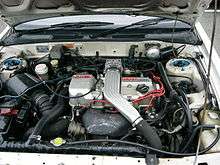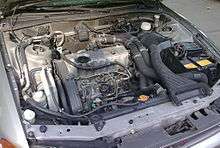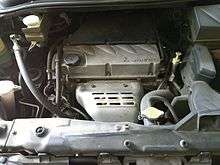Mitsubishi Sirius engine
| Sirius | |
|---|---|
| Overview | |
| Manufacturer | Mitsubishi Motors |
| Also called | 4G6/4D6 |
| Production | 1979–2006 |
| Combustion chamber | |
| Cylinder block alloy | Cast iron |
The Mitsubishi Sirius or 4G6/4D6 engine is the name of one of Mitsubishi Motors' four series of inline 4 automobile engines, along with Astron, Orion, and Saturn. The 4G6 are gasoline engines, the 4D6 diesels.
4G61
The 4G61 displaces 1595 cc (82.3 x 75.0 mm bore/ full length stroke). This engine was always DOHC 16-valve and used either Multi-point (MPFI) or Electronic Control (ECFI) fuel injection. A turbocharged version was also produced for the Mirage and Lancer. The 4G61 does not have balance shafts like the other 4G6x motors.
Performance
- 4G61 91 kW-124 hp @ 6500
- 4G61T (USA/Canada only) 99 kW-135 hp @ 6000 191 Nm/3000
- 4G61T (Japan) 145 HP-117.68 kW @ 6000 220.65 Nm/2500
Applications
- 1988–1992 Mitsubishi Mirage / Mitsubishi Colt (MPFI)
- 1988–1992 Dodge Colt / Plymouth Colt
- 1988–1992 Eagle Summit
- 1992–1995 Hyundai Elantra
4G62
The larger 1.8 L 4G62 was an SOHC 8-valve unit for longitudinal rear-wheel drive and all-wheel drive use. With an 80.6 x 88.0 mm bore and stroke, it displaces 1795 cc. It was available either in carburetor form, multi-point fuel injection, or ECI Turbo as found in the Lancer EX 1800GSR or 1800GT, and Cordia GSR.
Applications
- 1983–1989 Mitsubishi Cordia
- 1983-1989 Mitsubishi Tredia
- 1981-1986 Mitsubishi Delica/L300/Express
- 1984-1988 Mitsubishi Galant/Eterna
- 1980-1987 Mitsubishi Lancer EX 1800GSR or 1800GT (A175A)
- 1983-1987 Mitsubishi Chariot HR
4G62T
Turbocharged version of the 4G62.
4G63

The 4G63 was a 1997 cc version.
(85 mm bore x 88 mm stroke) SOHC and DOHC were produced. Both versions were available in either naturally aspirated and turbocharged form. For front-wheel drive applications, the turbocharged Sirius' name was changed to "Cyclone Dash". As fitted to the fifth generation Galant 200 PS (147 kW) JIS gross were claimed - the output claims later shrank to 170 PS - for the turbocharged and intercooled "Sirius Dash 3x2 valve" engine. This version could switch between breathing through two or three valves per cylinder, to combine high top-end power with low-end drivability as well as allowing for economical operation.[1] It was a modification of Mitsubishi MCA-Jet technology which used a secondary intake valve to inject air into the engine for more efficient emissions control. The DOHC version was introduced in 1987 in the Japanese market Galant, and came in turbocharged or naturally aspirated form. It is found in various models including the 1988-92 Mitsubishi Galant VR-4, the U.S. market 1990-1999 Mitsubishi Eclipse, and the Mitsubishi Lancer Evolution I-IX. Later versions also received Mitsubishi's variable valve-timing system, Mivec.
A SOHC carbureted eight-valve version (engine code G63B) was also available in Mitsubishi's pickup trucks (L200, Strada, Mighty Max, Dodge Ram 50) from the eighties until the mid-nineties. It produces 92 hp (69 kW) at 5,500 rpm in European trim (1989).[2] The SOHC version was also used in Mitsubishi Galant models until 1993. It has 76 kW of output and 157 Nm of torque at 4,750 rpm.
Also, a SOHC version was produced until the late 90s and early 2000s and was used in Mitsubishi cars like the Montero and the 2.0L 2-door Pajero with an output of 101 kW (137 PS) at 4,700 rpm. Also the N33 and N83 Spacewagon and Galant (UK market) received the 4G63, in single-cam sixteen-valve format. A similar version, with 100 PS (74 kW), was also used in some light duty Mitsubishi Canters from 1997 on.[3]
The Mitsubishi Eclipse, Eagle Talon and Plymouth Laser introduced the DOHC turbocharged intercooled version to the U.S. in 1989 through Diamond Star Motors, a joint venture between Mitsubishi Motors and the Chrysler Corporation. From 1990 to late April 1992 came thicker connecting rods and the use of six bolts to secure the flywheel to the crankshaft; May 1992 to 2006 Evolution versions have lighter rods and use seven bolts to secure the flywheel to the crankshaft. They are referred to as the "six bolt" and "seven bolt" engines, respectively.
Output for the 2003 US Mitsubishi Lancer Evolution is 271 hp (202 kW) at 6500 rpm with 273 lb·ft (370 N·m) of torque at 3500 rpm. It has a cast iron engine block and aluminum DOHC cylinder head. It uses multi-point fuel injection, has four valves per cylinder, is turbocharged and intercooled and features forged steel connecting rods.
The final version of the engine was found in Lancer Evolution IX. It was equipped with Mitsubishi's variable valve timing system, MIVEC. This version also had a revised turbocharger, extended reach spark plugs, two-piece rings.
Racing
Its turbocharged variant, 4G63T (also sometimes referred to simply as the 4G63), has powered Mitsubishi vehicles in World Rally Championships for years in the Mitsubishi Galant VR-4, Lancer Evolution, Carisma GT, and Lancer WRC04. It was the powerplant of the Lancer Evolution when Tommi Mäkinen won his four consecutive WRC championships in his Lancer. MHI and T-4 turbos were both used as power plants for these engines.
Applications
- 1981-1987 Mitsubishi Lancer EX 2000 Turbo
- 1997–2000 Mitsubishi Canter
- 2003–2007 Mitsubishi Lancer CS0
- 1983-1998 Mitsubishi Chariot
- 1988 Mitsubishi Cordia
- 1985–1998 Mitsubishi Delica
- 1990–1999 Mitsubishi Eclipse
- 1980–2003 Mitsubishi Galant
- 1987-1989 Mitsubishi L200/Mighty Max
- 1992–2007 Mitsubishi Lancer Evolution
- 1993–1998 Mitsubishi Pajero
- 1994–1998 Mitsubishi RVR
- 1982–1987 Mitsubishi Starion
- 1988 Mitsubishi Tredia
- 2003-2005 Mitsubishi airtrek
- Mitsubishi Dion
- 2004–present Brilliance BS6
- 1983–1992 Dodge Colt Vista
- 1987-1989 Dodge Ram 50
- 1989-1992 Eagle Vista Wagon
- 1990–1998 Eagle Talon
- 1987-1988 Hyundai Stellar
- 1992-2005 Hyundai Sonata
- 1990–1994 Plymouth Laser
- 1985 Proton Saga (Prototype)
- 1996–1999 Proton Perdana
- 2015–Present Landwind X7
- 2005-2015 Great Wall Haval H3
4G63T
Turbocharged version of the 4G63. ACL bearings lists the differences in journal lengths between different years of production, and whether or not it used a thrust bearing on the number 3 journal or thrust washers. There was a 2V and 4V 4G63T engine.
4G64
The 4G64 is the second largest variant, at 2,351 cc. Early models were 8-valve SOHC, but a later 16-valve SOHC and DOHC version was also produced. All used MPFI and had an 86.5 mm bore and 100 mm stroke. The 4G64 was later also available with gasoline direct injection. Output varies between 140 hp (104 kW; 142 PS) at 5,250 rpm with 161 lb·ft (218 N·m) of torque at 4,000 rpm in the Mitsubishi L200 and 152 hp (113 kW; 154 PS) at 5,500 rpm with 162 lb·ft (220 N·m) of torque at 4,000 rpm in the Chrysler Sebring/Stratus. The Chrysler version features fracture-split forged powder metal connecting rods. The DOHC and SOHC 16V 4G64 are interference engines, while the SOHC 8V 4G64 is a non interference engine. From March 1996 an LPG version with 115 PS (85 kW) at 5,000 rpm was available in the Mitsubishi Canter.[3]
Applications
- 1993-1997 Mitsubishi Chariot
- 1988–2006 Mitsubishi Delica/Van
- 1997-1999 Mitsubishi Eclipse GS Spyder Convertible FWD model equipped with a 141 hp (105 kW) 2.4 L 16-valve SOHC Mitsubishi 4G64 engine
- 2000-2005 Mitsubishi Eclipse
- 1994–2003 Mitsubishi Galant
- 1990–present Mitsubishi L200
- 1996–1998 Mitsubishi Magna (codenamed 4G64-S4 and fitted to the TE-TF series)
- 1990–1996 Mitsubishi Mighty Max
- 1998-2005 Mitsubishi Montero (V11 - 2 door) Latin America version
- 2001 Mitsubishi Airtrek
- 2003 Mitsubishi Outlander
- 1987–1990 Mitsubishi Sapporo
- 1986-2005 Mitsubishi Triton
- 2005 Mitsubishi Zinger
- 2003-2006 Kia Sorento 2.4i Manual
- 2004–present Brilliance BS6
- 2008–present Chery V5
- 1983–1992 Dodge Colt Vista (AWD only)
- 1990–1992 Dodge Ram 50
- 2006–present Great Wall Hover(X240 and V240)
- 1986-1998 Hyundai Grandeur
- 1989–1991 Hyundai Sonata
- 1999–2005 Hyundai Sonata
- 2001 Hyundai Santa Fe
- 2000–2005 Kia Optima
- 1998-2003 Mitsubishi Space Wagon
4D65
Known as the "Sirius Diesel", the 4D65 had the same dimensions as the 4G62 (1,795 cc). It was available either naturally aspirated or turbocharged, and was used in most Mitsubishi diesel passenger cars in the eighties and beginning of the nineties.
Applications
- 1983-1989 Mitsubishi Galant/Galant Σ/Eterna Σ
- 1983–1992 Mitsubishi Lancer/Lancer Fiore/Mirage Saloon
- 1983–1987 Mitsubishi Mirage/Colt
- 1984-1991 Mitsubishi Chariot/Space Wagon
- 1987-1991
4G67
The 16-valve DOHC 4G67 displaced 1836 cc. Bore x Stroke [mm]: 81.5 x 88
Applications
- Mitsubishi Colt III
- Mitsubishi Mirage
- Mitsubishi Galant Viento
- Mitsubishi Lancer
- Hyundai Elantra
c58a, c68a
4D68

Known as the "Sirius Diesel", the 4D68 version displaced 1998cc. It was fitted with a 93mm stroke crankshaft and the cylinder bore diameter was 82.7mm. This engine used pistons with a static compression ratio of 22.4:1 and piston pins were 25mm OD. It was available either naturally aspirated or turbocharged, and replaced the 4D65 as Mitsubishi's "go-to" diesel.
- Type : Diesel engine
- Number of cylinders: 4 in-line
- Combustion chamber: Swirl chamber
- Lubrication system: Pressure feed, full-flow filtration
- Oil pump type: External gear type
- Cooling system: Water-cooled
- Water pump type: Centrifugal impeller type
- EGR type: Single type
- Fuel system: Electronic control distributor-type injection pump
- Supercharging: Turbocharger
- Rocker arm: Roller type
Applications
- 1991-1996 Mitsubishi Mirage/Colt
- 1991-1996 Mitsubishi Lancer/Libero
- 1992-1997 Mitsubishi Chariot/Space Wagon
- 1996-2000 Mitsubishi Galant/Galant Break(Legnum)
- 1996-1999 Mitsubishi Lancer/Libero
- 1997-2002 Mitsubishi Mirage/Colt
- 1995-2000 Proton Wira 2.0D
- 2007-2008 Triton
4G69

The 4G69 is a 2378 cc version built in Shiga, Japan. Bore is 87 mm and stroke is 100 mm. Output is 162 hp (120 kW) at 5750 rpm (160 in the Sportback Wagon) with 162 lb·ft (219 N·m) of torque at 3500 rpm. It has a cast iron engine block and an aluminum SOHC cylinder head. It uses multi-point fuel injection, has 4 valves per cylinder with roller followers and features forged steel connecting rods, a one-piece cast camshaft, and a cast aluminum intake manifold. The 4G69 incorporates Mitsubishi's MIVEC Variable Valve Timing technology.
Applications
- 2003–2011 Mitsubishi Grandis
- 2004–present Hawtai Terracan
- 2004–2006 Mitsubishi Lancer
- 2004–2006 Mitsubishi Outlander
- 2004–2012 Mitsubishi Galant
- 2006–2012 Mitsubishi Eclipse
- 2008–present Mitsubishi Zinger for automatic models only
- 2008-early 2013 Great Wall Haval H3
- 2009–present Great Wall Haval H5
- 2011–2013 BYD S6
- 2012–present JMC Vigor 4x4 pickup
NB: From 2005 a slightly detuned version (115 kW, 220 N·m) is used across the entire Lancer range in Australia.
- 2011–2014 Geely EC8
- Of further note, the Great Wall Haval uses a completely detuned variant offering only 100 kW and 200Nm
See also
External links
| Wikimedia Commons has media related to Toyota U engines. |
References
- ↑ Yamaguchi, Jack K. (1985), Lösch, Annamaria, ed., "Japan: Lucrative Contraction", World Cars 1985, Pelham, NY: The Automobile Club of Italy/Herald Books: 51, ISBN 0-910714-17-7
- ↑ Mitsubishi Motors: Commercial Vehicle Range (brochure), Cirencester, Glos., UK: The Colt Car Company, 1989, p. 12
- 1 2 Takayoshi, Seiji (高吉 誠司), ed. (2011-03-17), "トラックメーカーアーカイブ vol.2: 三菱ふそうのすべて [Truck Manufacturer Archive Volume 2: Everything Mitsubishi Fuso]", Camion (in Japanese), Tokyo, Japan: Geibun Mooks (780), p. 66, ISBN 978-4-86396-112-8
- ↑ http://www.aclperformance.com.au/us/Mitsubishi4G63Tus.htm
- ↑ http://www.redbook.com.au/cars/research/used/details/2010-great-wall-x240-manual-4x4/SPOT-ITM-225879
- "Engine Epic Part 8 - Mitsubishi Engines", Michael Knowling, Autospeed, issue 48, 21 September 1999
| Wikimedia Commons has media related to Mitsubishi 4G6 engines. |